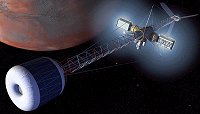Wednesday, January 14, 2004

Earth to Mars CEV?
Just one measure of the difficulty facing a human presence in deep space can be found in the August, 1993 NASA Technical Paper 3351 entitled Cellular Track Model for Study of Heavy Ion Beams (PDF).
This paper reports on experiments geared toward understanding the effect of Heavy Primaries upon living tissue.
Heavy Primaries is a term used to describe the radiological remnants of everything that has ever exploded in space from the Big Band to your average Super Nova along with radiation from active stellar structures.
An excellent article by Matthew L. Wald that I originally discussed on December 10, and still available on the New York Times Website, most effectively describes deep space radiation as:
Mostly ions of every element on the periodic table up to iron (No. 26), moving at a substantial fraction of the speed of light, and approaching from distant stars in all directions.
In the 1993 NASA experiment a particle beam is passed through a Monte-Carlo Track Structure, a medical standard for measuring radiological effects upon human tissue.
The terms aerobic and hypoxic conditions that are mentioned in the report refer to tissue samples within high Oxygen and low Oxygen environments.
This study examines the effect of a high-energy particle beam on tissue samples in differing environments as a way of simulating one beam of Heavy Primary radiation in deep space.
The authors of the study were trying to predict cell survival and RBE (Relative Biological Effectiveness) of tissue within a complex radiation field.
They claimed that:
Good agreement is found with experimental results for the survival of human T-1 cells exposed to monoenergetic Carbon, Neon and Argon beams under aerobic and hypoxic conditions.
Remember, this is just one beam of the most potent high energy we can create in a laboratory attempting to simulate a 3D bath of the most complex radiological field ever encountered with the exception of the even more calamitous entry of a solar flare into this very radioactive picture.
A future Mars traveler will likely have to spend, at least, a year within the super hot radiological zone of interplanetary space.
Regarding a Lunar Colony a 1999 NASA paper says:
A space colony must be encased in sufficient mass to shield colonists from radiation. This can be done with any mass, for example, large amounts of lunar soil. A 4.5-meter thick layer of lunar soil may be able to provide adequate protection. Active shielding by creating an electro-magnetic field tries to change the trajectories of charged particles.
Then, of course, there is the "bremsstrahlung" effect.
Just what is the "bremsstrahlung" effect, you ask?
Well according to an extract (a link to the original no longer works along with a not so surprising number of other links to government space radiation studies) from an undated Air Force and NASA study (scroll down):
A second major issue in shielding is the "bremsstrahlung" effect. Laboratory tests have shown that when shielding for a system is increased beyond a certain point, the secondary radiation produced in the shielding by the primaries increases, actually leading to higher doses of the radiation.
If you do not have a headache quite yet consider the Input Output rate calculated by Harry L. Shipman in February of 2000 for one human in space per day:
Inputs:
3.1 kg of food (dry weight)
15-20 kg of water (including drinking water and the water content of food)
4.4 kg of oxygen
Outputs:
7.3 kg of urine
8.8 kg of "metabolic water" -- exhaled in breathing and evaporated from the skin
4.8 kg of carbon dioxide
0.88 kg of solid waste
That comes to a, I would imagine, highly variable 1,132 kilograms of food required resulting in 2,665 kilograms of urine and 322 kilograms of solid waste produced per person per year!
Image: John Frassanito & Associates

